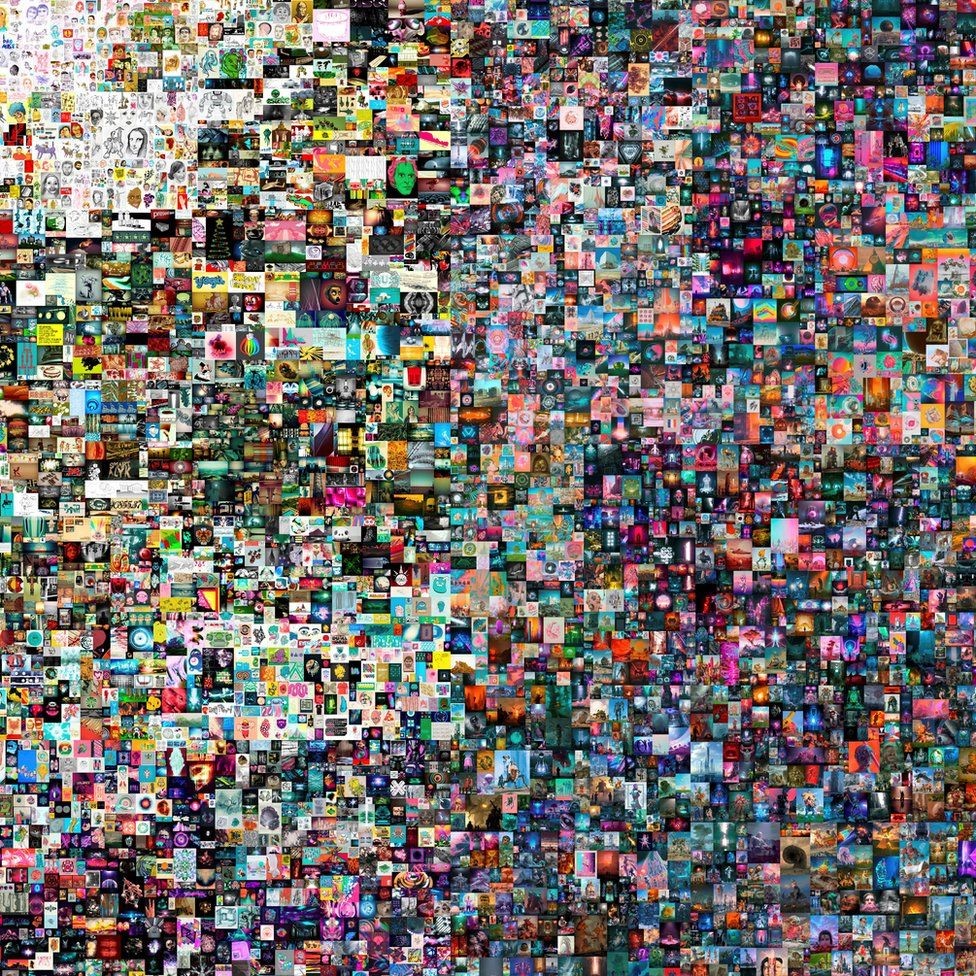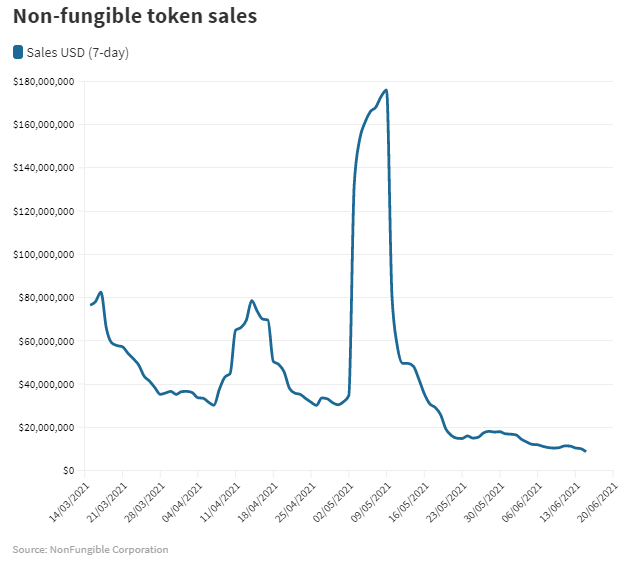What are NFTs? NON-FUNGIBLE TOKENS: EXPLAINED
Non-fungible tokens (NFTs) are units of data that are stored on a blockchain. This essentially guarantees that a given digital asset is unique and cannot be interchanged with something else. In recent times, there have been several reports of some NFTs being sold for millions – here we look at what they are and why people are paying so much for them.
In order to discuss something that is non-fungible, it makes sense to first take a look at what makes something fungible. The dictionary defines fungible as ‘being something (such as money or a commodity) of such a nature that one part or quantity may be replaced by another equal part or quantity in paying a debt or settling an account’.
A fungible asset then, is something that is composed of units – such as money – that can be readily interchanged. Thus, when something is non-fungible, it cannot be interchanged because it has unique properties that make it stand apart from anything else. If we think of what is arguably the most famous painting in the world – the Mona Lisa – we understand that there is only one of those, which currently hangs in the Louvre Museum.
While anybody can buy a print of the Mona Lisa (or a mug, t-shirt and even a tea towel with the Mona Lisa on it), the actual painting is one of a kind; there can only ever be the one original Leonardo da Vinci painting. NFTs work in a very similar way to this, albeit digitally.
WHAT IS AN NFT?
The Mona Lisa (or any other one-of-a-kind traditional work of art) is so valuable because of its unique nature. In direct contrast to this, digital files can be replicated and reproduced very easily, thereby making them essentially worthless, at least in monetary terms. But then someone had the bright idea of creating NFTs, which are tokens people can use as a means of representing ownership of a unique item. In a nutshell, an NFT is a digital asset that acts as a representation of a real-world object.
This is music to the ears of content creators around the world, who can now ‘tokenise’ their creations – whether that be an artwork, meme, collectible or video. Importantly, NFTs can only ever have one official owner at a time, ownership that is secured by the Ethereum blockchain. While it is still possible for people to modify, replicate and reproduce an artwork, they are unable to change the record of ownership or use the original NFT to create a new NFT.
Think about it: there are countless versions of the Mona Lisa that have been edited, but none of these versions have any bearing on the original painting hanging on the wall of the Louvre. In the same way, people can do what they want to a digital artwork and repost it – but they cannot change the status of ownership for a particular NFT.
HOW DO NFTS WORK?
NFTs are bought and sold online, typically through the Ethereum blockchain. As many of you will no doubt be aware, Ethereum is a cryptocurrency, but its blockchain is able to support NFTs. Blockchains – a distributed physical ledger that records transactions – make NFTs possible in the same way that they make cryptocurrencies possible. However, NFTs store information that makes them work differently to cryptocurrencies (although they are built using the same type of programming).
More and more blockchains are able to support NFTs these days and the capability of other blockchains is likely to increase as time goes on. There is already evidence of massive growth within the NFT ecosystem, especially as more and more people realise the potential impact that NFTs can have. We have already seen cryptocurrencies like Bitcoin come a long way, so it is not unreasonable to expect NFTs to follow a similar path.
HOW MUCH ARE NFTS WORTH?
The short answer to the question of how much NFTs are worth is “Whatever people are prepared to pay for them.” The long answer is more complex and, in a similar way to Bitcoin (and other cryptocurrencies that have gained increased exposure and media coverage around the world), the more that is written about NFTs, the more people will become interested in investing. The more people interested, the greater the value of any given NFT – theoretically, anyway.
In the last few months alone, there have been several instances of people paying many millions for an NFT. In March 2021, the artist Beeple (whose real name is Mike Winkelmann), sold the first purely digital NFT-based artwork offered by a major auction house. His piece, entitled The First 5000 Days, was sold by Christie’s for $69,346,250 (£50 million).

The First 5000 Days
Beeple is an American graphic designer who started creating a new piece of digital art every day at the beginning of 2007. The First 5000 Days is a collage of these collections, stretching across more than 13 years. Of course, many of you sitting there reading this will be thinking “How can that be worth £50 million?!” – and the person sitting here writing this is not going to disagree with you.
However, such sales attest to the power of hype. There are those (including Beeple) that believe the current craze for NFTs is a bubble that will soon burst but, for now, people are prepared to pay seemingly exorbitant amounts for a unique creation.
THE MOST VALUABLE NFTS EVER SOLD
Unsurprisingly, Beeple’s Everydays: The First 5000 Days comes in at number one in a list of the most valuable NFTs ever sold, but it might not take long for it to be eclipsed by another sale in the coming months. Here is a round-up of the current ten most valuable NFTs (highest first):
- The First 5000 Days ($69 million)
- CryptoPunk #3100 ($7.58 million)
- CryptoPunk #7804 ($7.57 million)
- Crossroad ($6.6 million)
- The First-Ever Tweet ($2.9 million)
- CryptoPunk #6965 ($1.6 million)
- Axie Infinity Virtual Game Genesis Estate ($1.5 million)
- CryptoPunk #4156 ($1.5 million)
- Forever Rose ($1 million)
- Metarift ($904,413)
It is worth noting that with the fluctuating value of cryptocurrency, many people have become rich in a very short space of time. For instance, Axie Infinity Virtual Game Genesis Estate was purchased for 888.25 Ethereum by someone known as Flying Falcon. Of course, this has a real monetary value (in that it can be exchanged for money), but in many ways, the figure is just a number on a screen and is not really there (in much the same way as the NFT being purchased is not really there).
Still, the seller will not be complaining and it will certainly feel very real to him.
WHAT NEXT FOR NON-FUNGIBLE TOKENS?
In the first quarter of 2021, total sales of NFTs were around the $2 billion mark but in recent weeks, there has been a dramatic fall in sales. This has led many people to question whether the NFT bubble has already burst, while others say that the recent slowdown is just a temporary blip.

The truth is, nobody knows what is going to happen to the NFT market throughout the rest of the year and beyond. It is quite a common occurrence to see a relative decrease in a trend when there has been a dramatic increase – an effect of market stabilisation.
One thing that may see NFTs take off again is the potential usage of them. Kings of Leon offered their latest album, When You See Yourself as an NFT and other musicians could well follow suit in the future. The internet created many problems for recording artists years ago, when digital piracy hit them hard; the rise of streaming sites has helped combat some of those issues, but then there are problems with the percentage of royalties musicians receive from the likes of Spotify and Apple Music – NFTs are a possible means for artists to overcome this.
Innovation drove the rise of NFTs and it could be the force that sustains its market potential for years to come.
